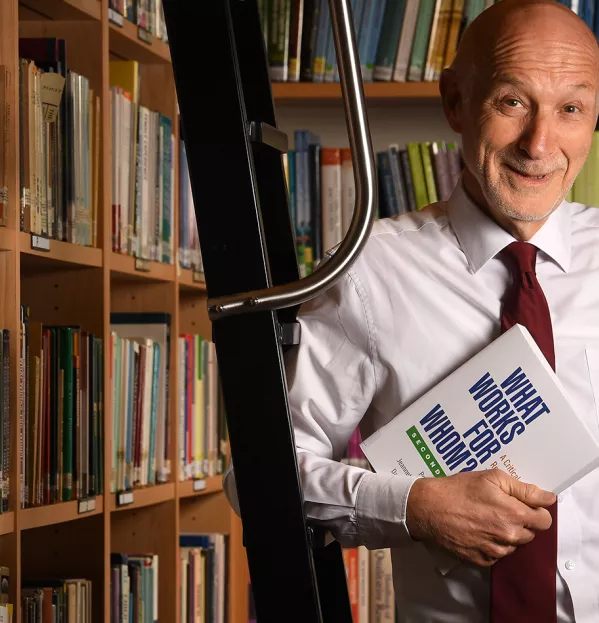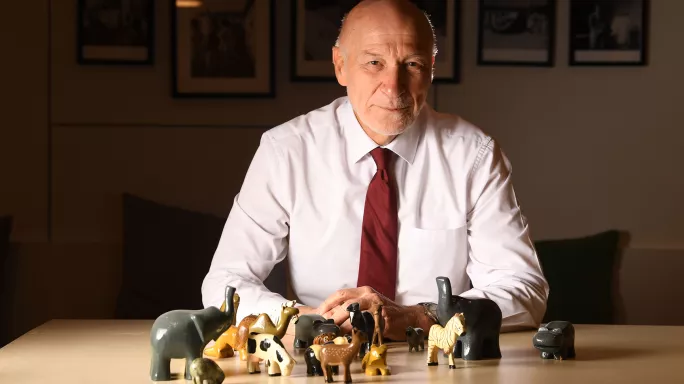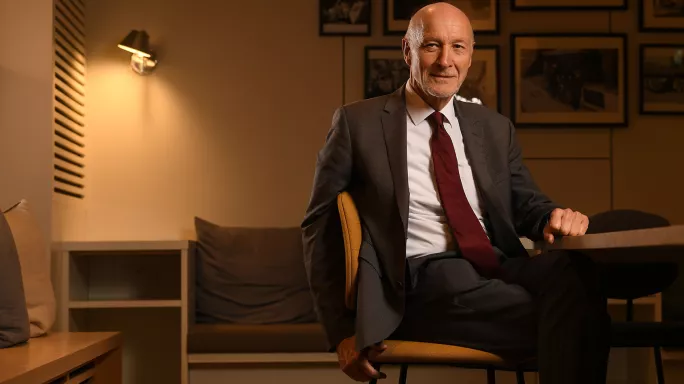
- Home
- Teaching & Learning
- General
- Why it matters whether your students like you
Why it matters whether your students like you

Peter Fonagy knows a thing or two about the importance of human relationships.
As head of the division of psychology and language sciences at University College London and chief executive of the Anna Freud Centre, with visiting professorships at both Yale and Harvard Medical Schools, Fonagy is an expert in early attachment issues.
His interest in why close relationships matter started much earlier, though: when he arrived in the UK from Hungary as an unaccompanied refugee, aged just 15.
“My parents and my sister were in another country, and I was here on my own. I couldn’t speak any English and I went to a terrible school where I got bullied a lot,” he explains.
The experiences he had back then, he says, are the driving force behind his desire to study early development and the way that our first relationships go on to shape what happens throughout our time at school, and for the rest of our lives.
“If I’m honest about it, it’s because of my own struggles as an adolescent, and just understanding how difficult it is,” he says.
To find out more about how the science of attachment informs what happens in the classroom, Tes sat down with him to discuss his research and what teachers can take from it.
Tes: Could you start by giving us an overview of what attachment theory is?
Peter Fonagy: Attachment is a big thing in primate groups, and for humans in particular.
The reason it’s so important for humans is because we are bipedal [we walk on two legs]. And the problem with that, in combination with having big heads, is that, in order to fit down the birth canal, we have to be born when we are still very immature. What that means is we need protection for quite a long time in order to develop.
This is a standard evolutionary story: we are vulnerable, we need protection and we develop devices to make sure that we are cared for. For example, we cry in a way that those around us find distressing, and they want to make it stop.
One of the things I say to parents struggling with crying infants is, “Look, you’re just a victim of evolution.”

Is our drive for attachment all about protection, then?
The interesting thing is that, in humans, that system of wanting to seek proximity got hijacked by the need for our brains to develop, supported by another human mind. That’s not simply to do with comforting your baby. It’s much more to do with evolution saying, “Ah, if I link up with this person who teaches me all the things I need to know, it will help me survive in the world”.
So, that relationship between the caregiver, whoever that is, and the infant becomes important - not just because the caregiver gives care, but because the infant actually looks to the caregiver to learn about the environment as they come with very little preparedness.
The infant brain is really ready to learn, and it has taken that caretaking situation as a main mechanism for acquiring new knowledge about the environment.
Does it make a difference how the ‘caretaker’ acts in response to the child?
Yes. An important part of the process is the infant figuring out how much they have to manage on their own in this environment, and how much they can assume that they’ll always be looked after.
This is one of the things that the infant susses out by observing how preoccupied with other things the person looking after them is. If the person looking after them deals with them in a way that’s quite sensitive and follows a pattern of “serve and return” - they do something; the caregiver does something - this is what we call “contingent responding”. It means the infant works out: “Yes, this is the kind of environment where I can rely on other people, because they have the resources to take care of my needs.”

That’s the best-case scenario, but obviously not every child will be responded to in this way. What happens then?
If the child has an environment where that doesn’t happen, then they have one of two strategies. One strategy is to manage on their own. The other is to just turn up the volume and cry even louder, and pretend they’re not responding when you come, because they’re not sure if you will go again too quickly.
So, these children are a bit more needy. That’s the core attachment idea, formulated by [psychiatrist] John Bowlby.
What’s interesting for humans is that, because infants learn so much in these early relationships, what they learn in terms of strategically engaging the person that’s looking after them kind of embeds in the brain and becomes a somewhat lasting strategy.
In fact, what we now know is that children probably have a whole range of strategies, and they cycle through these in the rest of their relationships. As they grow up, they use strategies that fit that particular relationship.
What type of strategies?
So, for example, you nod very well; that makes me much more relaxed. But if I was here talking and you were just stone faced, then I would try to use another strategy, perhaps the baby’s strategy of increasing my signals. I would try to make a nuisance of myself to get a response from you.
‘Ultimately, a child has to believe that an adult is trustworthy in order to learn from them’
It’s not that the strategies children acquire early on are the only ones they have. But if, as for most of us, the environment we are in pretty much repeats itself, then those strategies get more embedded and the set you have gets narrower.
We’ve talked so far about how infants interact with their early caregivers, but how does this apply later on, when young people are interacting with teachers in the classroom?
What I think we’ve developed an understanding of now that we didn’t have before is that, for humans, the importance of just responding to another person sensitively is because we are different from other primates in a really exciting way: we pass on what we have learned from one generation to the next. We call this “culture” and the real people responsible for this are teachers.
There is a really interesting part to that, which teachers sometimes don’t realise.
Because they are part of this evolutionary mechanism that is built on attachment, it actually matters whether they are liked or not. It matters whether the child feels that the teacher is sympathetic, that they “nod”, in a way, to their individual needs.
Sometimes, teachers don’t realise they are carrying this evolutionary burden. We’ve got fancy words for this, but ultimately, a child has to believe that an adult is trustworthy in order to learn from them.
The simplest mechanism for deciding whether somebody is trustworthy is asking: are they interested in me? If they’re not interested, they’re not trustworthy, and a little bit of the child’s mind then closes, and they don’t listen so well.

Is that true regardless of the type of attachment the child has experienced in early life or does it change depending on what they’ve been through?
We have always known that a child who’s had the background of being looked after by someone who was very sensitive will learn language faster, gain more IQ points and be “brighter”. But we have never really understood why.
Well, now we know it’s because they’re more trusting. And they’re more immediately open. A less secure child needs more help. It’s not that they can’t do it, but they need more support.
A child who is very traumatised, on the other hand, is a different case altogether. These children develop a kind of vigilance and are sometimes even hypervigilant: they really just close their mind. It’s not that they don’t understand; it’s more that it doesn’t stick. And you repeat it and it still doesn’t stick.
That can be fairly frustrating for teachers. You may have provided a safe environment in which they can trust you. But, actually, what you’ve got to be aware of is that outside of that environment, there may be experiences that, to them, feel very unsafe.
And that’s very hard for teachers because it’s very unfair on these children, but there’s nothing that they can do.
Does that mean there is no way to help those children?
That is very deterministic. I think it would be a very stupid evolution that made things irreversible. And evolution is not stupid.
What I was trying to say is that the reason behaviour gets embedded is because environments tend not to change, so it gets reinforced. And unfortunately, it then cascades, so the kids that I deal with in some ways create the environment that will then reinforce it further. Say they are attention seeking and people respond to that negatively. Their mind says: “Well, I told you so. You have to be careful, or you’ll get shouted at.”
‘Even when a child is mentally unwell, you’re not there to heal them. That’s not your role’
So, there is an inevitability about it. And I accept that. But I don’t think it’s an inevitability that’s built into the system; it’s in the brain.
And, you know, there are millions of stories of how a child can discover one good relationship with a teacher or a coach, or whatever, and it actually makes a hell of a lot of difference.
What can a teacher do to support a child who isn’t trusting?
Firstly, there’s no point in any teacher becoming an amateur counsellor or psychotherapist. But they can do a great deal as a calm role model who can listen and give sensible advice about the problems that a kid is facing at home, or about the problems they have in how they get on with other children, or whatever.
The critical word there is “listen”. First, you listen, and then you give the advice. Sometimes, you know what the advice should be before the child has even had a chance to say anything but, actually, what establishes the trust is the child expressing the problem and then you responding with valuable communication.
The second thing is for teachers to work with parents even more than they already do. In the classroom, you may actually be able to do less than you can do on parents’ evenings.
But your most valuable role is identifying the problem, not necessarily solving it. So, if you accept the model that part of the problem is that the child recreates these relationships that are unhelpful, by being calm, you stop that from happening. When you talk to parents, you can tell them to be calm as well.
That’s not being a “therapist”. It’s just getting the parents to be effective teachers, too. You are role modelling yourself for the parents.

Many teachers would say that this is easier said than done. How would you respond to that?
I know it’s easy for this to become “counsel of perfection”. Ultimately, though, I think it’s really important to just do what you would do anyway as a good teacher.
Even when a child is mentally unwell, you’re not there to heal them. That’s not your role.
But by doing your job properly, by having a well-organised classroom where there is connectedness, where you generate optimism, you generate happy feelings, you show engagement with all the other children, these children can see that as well. You’re not so much focusing on them, but just by your class functioning well, you’re actually helping these kids to structure their own minds. You can just do your job and you’re helping.
Are there any specific interventions that teachers can use that aren’t geared towards ‘healing’ the child, but which might help a pupil who is struggling nonetheless?
Often, what these kids don’t have is perseverance or “grit”. The simple way of putting it is: they give up too easily. Where you can be different with them is to give them a little bit more room to learn to persevere. While the secure kids persist and do so until you say “well done”, with these kids, if you didn’t say “well done” in the first 30 seconds, they give up. Just being mindful of that makes a real difference in how you relate to them.
‘You shouldn’t worry about children being attached to you; that’s a good thing, and they learn better’
A good teacher would recognise that, anyway. But that’s a great vulnerability in these kids. The reason they can’t thrive, often, is because they can’t engage. They can’t persevere. They feel very pessimistic about the world. They feel disconnected. They feel quite unhappy. It’s not mental illness; it’s just what their lives have left them with.
And that’s also good teaching: engage them, connect with them, be joyful, happy, optimistic and help them to persevere. That’s what you can do to undo it, as it were.
The biggest discovery I had when I worked with violent adolescents was that it was a terrible idea to just sit in a room with them. A waste of time. I discovered it was much better to go for a run with them. Exercise is brilliant, and then they listen to you. Another distraction, like listening to music, can also work.
What’s the most important thing you think all teachers need to know about attachment?
That relationships are really important. It’s in our DNA. And you shouldn’t worry about children being attached to you; that’s a good thing, and they learn better.
But actually, attachment is not that different from teaching, and therefore, just good teaching creates a secure learning environment. So, often, what teachers learned in their teacher training about good teaching is actually good stuff for attachment as well.
I’m really aware of how much the Covid-19 pandemic had an impact on the work of teachers and that they did a superb job to make sure that things are only as bad as they are, as opposed to 100 times worse.
If you ever needed experimental evidence to show how important teachers and schools are, the pandemic is the best evidence you can have. It messed everything up for children, all because they closed the bloody schools.
I don’t know that there would have been a better way of doing it, says he, in hindsight, but I do think it shows just how important teaching is.
Helen Amass is teaching and learning editor at Tes
You need a Tes subscription to read this article
Subscribe now to read this article and get other subscriber-only content:
- Unlimited access to all Tes magazine content
- Exclusive subscriber-only stories
- Award-winning email newsletters
- Unlimited access to all Tes magazine content
- Exclusive subscriber-only stories
- Award-winning email newsletters
You need a subscription to read this article
Subscribe now to read this article and get other subscriber-only content, including:
- Unlimited access to all Tes magazine content
- Exclusive subscriber-only stories
- Award-winning email newsletters
- Unlimited access to all Tes magazine content
- Exclusive subscriber-only stories
- Award-winning email newsletters
topics in this article



